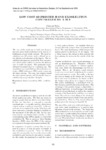Low cost 3D-printed hand exoskeleton controlled by a BCI
Title
Low cost 3D-printed hand exoskeleton controlled by a BCIDate
2018Citation
Wilms, C., Rodríguez-Ugarte, M., Iáñez, E., Azorín, J. M. Low cost 3D-printed hand exoskeleton controlled by a BCI. En Actas de las XXXIX Jornadas de Automática, Badajoz, 5-7 de Septiembre de 2018 (pp.15-20). DOI capítulo: https://doi.org/10.17979/spudc.9788497497565.0015 DOI libro: https://doi.org/10.17979/spudc.9788497497565
Versions
http://hdl.handle.net/10662/8112
Abstract
[Abstract] The aim of this work was to build and design a low-cost active hand exoskeleton to be used in rehabilitation of post-stroke patients. The hand exoskeleton was 3D printer and it allowed an active flexion and extension of the fingers. The exoskeleton designed was powered by three servomotors which pulled tendons to shorten the distance over or under the joints. This produced a natural hand movement close to a biological one. The exoskeleton was controlled by a Brain-Machine interface (BMI) utilizing an EEG-cap for measuring the brain activity. This way, two subjects tested the whole system opening and closing the hand exoskeleton by using only their thoughts. [Resumen] El objetivo de este trabajo fue construir y diseñar un exoesqueleto de mano activa de bajo costo para ser utilizado en la rehabilitación de pacientes post-accidente cerebro vascular. El exoesqueleto de mano era una impresora 3D que permitía una flexión activa y extensión de los dedos. El exoesqueleto diseñado fue impulsado por tres servomotores que tiraban de los tendones para acortar la distancia sobre o debajo de las articulaciones. Esto produjo un movimiento natural de la mano cerca de uno biológico. El exoesqueleto fue controlado por una interfaz Brain-Machine (BMI) que utiliza una tapa EEG para medir la actividad cerebral. De esta manera, dos sujetos probaron todo el sistema abriendo y cerrando el exoesqueleto de la mano usando solo sus pensamientos.
Keywords
Hand exoeskeleton
BMI
Rehabilitation
BMI
Rehabilitation
Editor version
Rights
Atribución-NoComercial 3.0 España
ISBN
978-84-09-04460-3 978-84-9749-756-5 (UDC electrónico)







